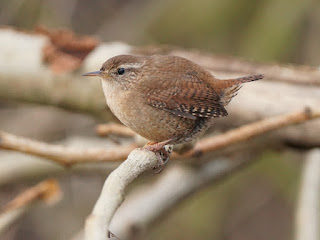Long-Tailed Tits are going around in pairs now rather than their winter family flocks. One at the northwest corner of the bridge inspected a sprouting leaf.
The Coal Tits at Mount Gate are also a pair.
The Robin by the Henry Moore sculpture sang a few phrases. He has a mate somewhere in the bushes, and the two are just beginning to notice each other again after their winter solitude.
The Robin in the leaf yard followed me for a few minutes, coming to take pine nuts. He was accompanied by some Great Tits which he chased away with even more ferocity than the Robin in the Flower Walk.
I only ever see one Wren in the leaf yard, but I'm sure there are others deeper in the bushes. Male Wrens maintain harems of females, each with a nest.
The Redwings were still on the Parade Ground, but as usual disappointingly far away.
Earlier than I'd expected, the young Grey Herons in the nest on the island have got restless and started climbing around in the tree. They can't be more than a month old but their growth rate is staggering: they are nearly adult size and have a full set of flight feathers, though they won't be flying yet. One of their parents was lower down in the front of the nest.
The pair of Lesser Black-Backed Gulls on the Long Water were on posts at the Vista. They often visit the raft where I thought they might nest, but have shown no sign of wanting to yet.
Pigeon Eater had struck, fed and gone, and a young gull was finishing the scanty leftovers.
This must have been Pigeon Eater's son, since his mother was standing a short way up the shore and would have chased him away otherwise. She would have taken her share first. (We're only guessing that the young one is a male because it's pretty big.)
The female Great Crested Grebe from the island was searching for fish hiding in debris washed up against one of the boathouses.
The young Moorhen in the Italian Garden, standing in its favourite place on one of the planters, is looking badly frayed in its teenage brown feathers. I looked up the moulting time of Moorhens and this seems to be in the summer, so it will have to wait several months for its darker adult set.
The killer Mute Swan has taken over the nesting island on the Long Water that was built for the resident swans that he murdered. His proprietorial air was upstaged by a Cormorant standing in front of him.
The last surviving Egyptian gosling on the Round Pond has made it through another day. Its parents took it to graze at the edge.
But it's sad news from the Egyptians at the Henry Moore. The female is down from her nest hole and she doesn't have any goslings with her.
Joan Chatterley found a group of at least ten Mandarins in Battersea Park, and here is her picture of some of them.
We haven't had any here this year. Maybe the Mandarins prefer Battersea because there are fewer big gulls, though you would have thought that quite a few of these must fly in from the river.
A squirrel sat on the post in the Dell where it sharpens its teeth by gnawing the aluminium sign, which is now badly eroded. It was eating peanuts which someone had given it.






's%20son%20eating%20leftovers%202024%201a.jpg)
's%20mate%202024%202a.jpg)



%202024%201a.jpg)

Isn't it unusual for such large birds to attain almost adult size in so little time? I'm thinking for instance of black vultures in comparison, which take ages to reach full adult size.
ReplyDeleteThe Cormorant photobombing the killer swan is either too brave or too foolhardy for its own good.
Young Grey Herons really do grow explosively on a very high-protein diet of regurgitated fish. I may have missed the start of sitting on the eggs by a few days -- I first saw it on 22 December -- but only by a few days, as I was watching the nest closely.
Delete